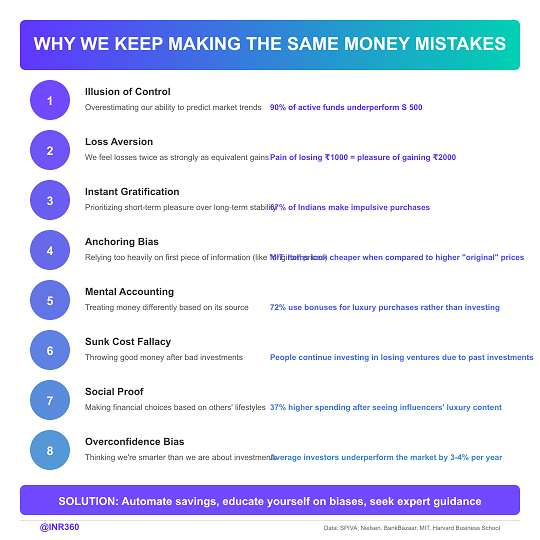Introduction: Why We Keep Making the Same Money Mistakes
Money is more than just numbers—it’s emotions, habits, and subconscious biases at play. Despite our best efforts, we often find ourselves repeating the same financial mistakes. Why do we overspend, avoid investing, or fail to save consistently? The answer lies in behavioral psychology. In this article, we explore the hidden psychological forces behind common money mistakes and how to overcome them.
1. The Illusion of Control: Thinking We Have More Financial Power Than We Do
The Mistake: Overestimating Your Ability to Predict Market Trends
Many investors believe they can time the market, but studies show that even professional fund managers struggle to consistently outperform passive index funds.
Real Data: A 20-year analysis by SPIVA (S&P Indices Versus Active) found that over 90% of actively managed funds underperformed the S&P 500.
Solution: Stick to long-term investment strategies and avoid making impulsive trades based on short-term trends.
2. Loss Aversion: Why We Fear Losing Money More Than We Love Gaining It
The Mistake: Holding Onto Losing Investments Too Long
Loss aversion is a powerful cognitive bias where we feel the pain of losing money twice as strongly as the pleasure of gaining the same amount.
Example: Investors hold onto losing stocks in the hope that they will recover, rather than cutting their losses and reallocating funds efficiently.
Solution: Set stop-loss limits and regularly evaluate your investment portfolio without emotional attachment.
3. Instant Gratification: Why We Overspend Instead of Saving
The Mistake: Prioritizing Short-Term Pleasure Over Long-Term Stability
We’re wired to seek immediate rewards, which leads to impulse spending.
Data Insight: According to a Nielsen report, 67% of Indians admit to making impulsive purchases, often influenced by online shopping deals.
Solution: Implement a 48-hour rule—wait two days before making any non-essential purchase.
4. Anchoring Bias: How Arbitrary Numbers Influence Your Financial Decisions
The Mistake: Relying on Initial Prices or Information Too Heavily
Retailers use anchoring by displaying inflated “original prices” next to discounts, making you think you’re getting a better deal.
Case Study: A study from MIT found that when shoppers were shown a product priced at ₹1,500 with an “original price” of ₹3,000, they were more likely to buy it—even if the actual market value was ₹1,500.
Solution: Compare prices across multiple sources and evaluate the actual utility of a purchase.
5. Mental Accounting: The Trap of Categorizing Money Incorrectly
The Mistake: Treating Money Differently Based on Its Source
People tend to spend windfalls (e.g., bonuses, tax refunds) more recklessly than their regular income.
Example: A survey by BankBazaar found that 72% of respondents used their bonuses on vacations or luxury purchases rather than saving or investing.
Solution: Allocate all income into a structured budget, regardless of its source.
6. The ‘Sunk Cost Fallacy’: Why We Stick With Bad Financial Decisions
The Mistake: Throwing Good Money After Bad
People continue investing in losing ventures due to emotional attachment and past investments.
Example: Holding onto a failing business because you’ve already invested ₹10 lakh, rather than cutting losses and pivoting.
Solution: Make financial decisions based on future potential, not past expenses.
7. Social Proof & Keeping Up with the Joneses
The Mistake: Making Financial Choices Based on Others’ Lifestyles
We compare our financial decisions to peers, leading to overspending on status symbols.
Case Study: A study from Harvard Business School found that people increased spending by 37% after seeing social media influencers promote luxury lifestyles.
Solution: Define personal financial goals based on long-term security, not social validation.
8. Overconfidence Bias: Thinking We’re Smarter Than We Are
The Mistake: Ignoring Expert Advice & Taking Unnecessary Risks
Investors often overestimate their knowledge, leading to risky bets in stock markets.
Data Insight: Dalbar’s Quantitative Analysis found that the average investor underperforms the market by 3-4% per year due to poor decision-making.
Solution: Seek expert financial advice and diversify investments.
Conclusion: How to Avoid These Psychological Traps and Money Mistakes
Understanding the psychology behind money mistakes can help you break negative financial habits.
- Track your spending to identify patterns.
- Set automated savings & investment plans to remove emotional decision-making.
- Educate yourself on biases and behavioral finance.
- Seek expert guidance before making major financial decisions.
By recognizing these hidden psychological forces and your money mistakes, you can make smarter, data-driven financial choices and build long-term wealth. 🚀
You might also be interested in: How to Get Out of Debt Fast: Proven Debt Reduction Strategies That Work
Visual Recap: Money Mistakes




